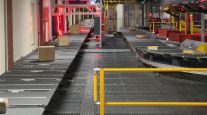Moving Manatees, Elephants and Pandas Requires Careful Planning, Preparation
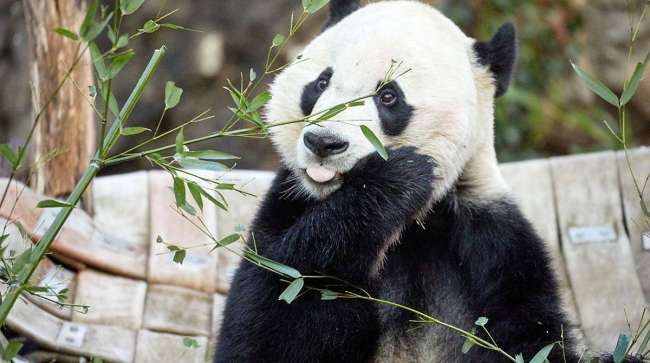
[Stay on top of transportation news: Get TTNews in your inbox.]
Some of Joe Collopy’s more exotic logistics assignments have earned him a unique nickname — Dr. Dolittle.
Collopy, who is director of air capacity sales for the DHL Express Americas hub at Cincinnati/Northern Kentucky International Airport, has arranged transportation for more than 100 animals, including racehorses, tigers, white rhinos and flamingos during his 36-year career.
And since 2004, when the Cincinnati and Columbus zoos were first chosen as caretaker facilities for Florida’s manatee recovery program, he has led the DHL operations team in ferrying about 25 Florida manatees to and from the Miami and Orlando, Fla., airports.
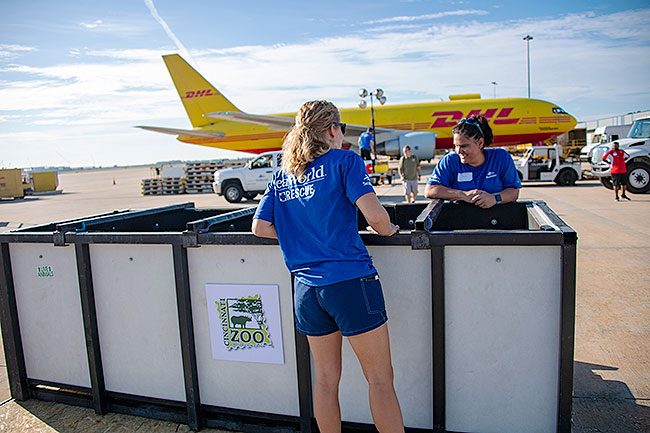
Manatee container on tarmac by DHL Express
DHL contracts with various independent cargo airlines, some of which operate aircraft branded with the distinctive red and yellow DHL colors and logo.
While the cargo handlers on Collopy’s operations team enjoy teasing him with the double meaning of his nickname, “Dr. Domuch” might be a better moniker for Collopy and other industry professionals charged with transporting large and unusual animals.
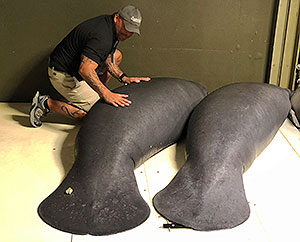
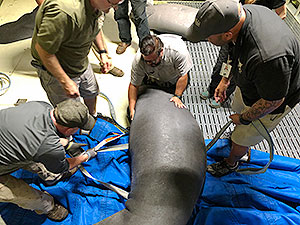
A curator preps manatees Michael and Matthew (top). The team prepares to lift Matthew (bottom). (DHL Express)
“About four to five months out, we begin lining up the planes that can be used in the transportation of the animals,” Collopy said. “For the actual flight itself, the main driver in getting things started post-9/11 comes in getting [Federal Aviation Administration] jump-seat approval for the zoo handler and the veterinarian who moves with the manatees. We must also work with the airlines to arrange extensive background checks for the veterinarian and handler for cockpit access on the aircraft.”
The manatees move on regularly scheduled flights between Cincinnati and Miami or Orlando rather than on charters, Collopy said, but due to the weight of the aquatic mammals, the cargo must be rearranged for proper weight balance on the flights.
Whether transporting animals across the country or around the world, logistics managers such as Collopy must work through myriad details: How will the animals be transported? When can they be loaded? How long can they remain in their containers during the trip? Will they need food and water during the trip and if so, how much? What permits or special permissions are required? Will their handlers be accompanying them? Will they need to be restrained during the trip?
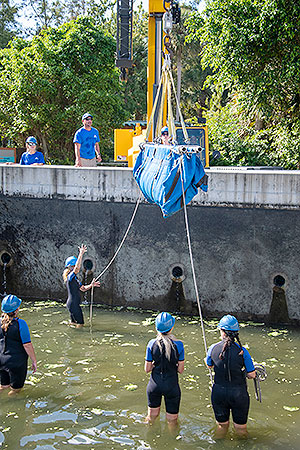
A manatee is lifted into its container. (DHL Express)
The Florida manatees, which can weigh up to 1½ tons, are not transported in water even though they live their entire lives in it. However, the manatees’ skin must be kept hydrated and the animals kept warm using thermal blankets for the duration of the 2- to 2½-hour flight, Collopy said.
The manatees are loaded onto the aircraft in containers placed on a large tray designed to collect and impound water and waste during the flight. Ground transportation to and from the airports is arranged by the zoos.
But why move these animals in the first place? There are a number of reasons.
Florida manatees struck by boat propellers or caught in fishing gear or irrigation locks, for example, often require care and rehabilitation until they can become well enough to be released back into the wild.
Then there are elephants, a surprisingly close relative of the manatee. Often, elephants must be moved for breeding purposes to keep captive populations genetically diverse.
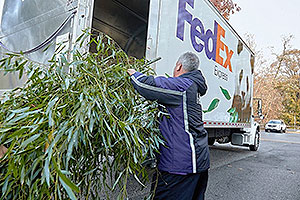
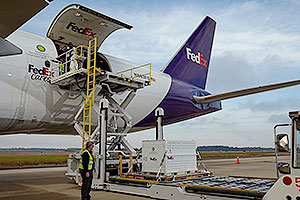
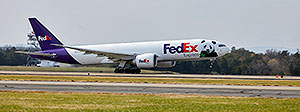
Bamboo is unloaded (top) for Bei Bei's trip to China. Bei Bei's crate (middle) is loaded onto the plane. FedEx Panda Express (bottom) takes off for China. (FedEx)
Also, following the adoption of new minimum requirements for elephant care by the Association of Zoos and Aquariums in 2011, a number of zoos over the past several years have chosen to close their elephant exhibits and move their animals to other zoos and sanctuaries with the proper facilities to meet the new standards.
Then there’s Bei Bei, a 240-pound male giant panda born in 2015 at the Smithsonian’s National Zoo in Washington, who was flown to China aboard a custom-decaled FedEx Express Boeing 777 freighter in November as part of a diplomatic program between the United States and China.
Most captive pandas around the world are property of the Chinese government and are on a temporary loan from China. Bei Bei’s loan agreement stipulated that he must be returned to China when he reached 4 years of age. Bei Bei’s parents will remain in the United States until the term of their lease expires later this year.
Bei Bei’s nonstop 16-hour flight from Washington to Chengdu featured a generous in-flight supply of his favorite snacks, including 66 pounds of bamboo, 2 pounds of apples and pears, two bags of Leaf-Eater biscuits, 2 pounds of cooked sweet potatoes and all the water he could drink.
Prior to the flight, Bei Bei spent a month getting acclimated to the crate space so that the journey could be made in a familiar environment.
It’s especially important for their safety and the safety of their transporters for animals to feel comfortable with the transportation equipment, said Stephen Fritz, of Stephen Fritz Enterprises Inc., which specializes in the transportation of elephants.
Fritz and his wife, Phyllis, own and operate the Kingman, Ariz.-based company.
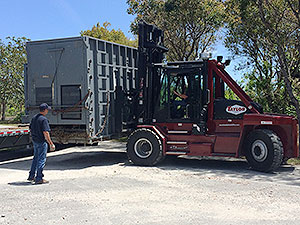
The crates weigh as much as 17,000 pounds. (Stephen Fritz/Stephen Fritz Enterprises)
Fritz operates a 2006 Western Star truck plus two custom-built trailers made by Jet Trailers — a tandem-axle double-drop trailer and a 48-foot tri-axle step-deck trailer.
The tandem-axle double-drop trailer allows Fritz to haul the elephant crates at a height that can easily pass under 13-foot, 6-inch overpass clearances while maximizing the center load capacity.
While the third axle on the tri-axle step-deck trailer doesn’t add more payload capacity, it smooths out the ride so that when the elephant moves, gets up or sits down, much less of that movement radiates through the truck and trailer.
The Fritzes use massive crates weighing as much as 17,000 pounds to carry the animals.
They also have a crate specially engineered to travel on a 747 cargo plane. They use this crate for moving elephants longer distances, particularly overseas.
The crates are designed with lifting straps, winches and air bags, which can be used to help lift the pachyderms should they lie down and require assistance getting back up. Due to their massive size, elephants cannot remain lying down or they would suffocate from their own weight. So, they generally sleep standing up, Fritz said.
“While many of our clients already do this, we require zoos to start a training program for the elephants weeks, even months before the transport,” Fritz said. “We’ll ask that they place the crates where the elephants can walk inside and become familiar with accessing them. They need to be able to stand comfortably within the crates while eating and drinking from the crate’s watering device. We also require placing leg restraints on both front legs and at least one rear leg. I won’t transport elephants without restraints.”
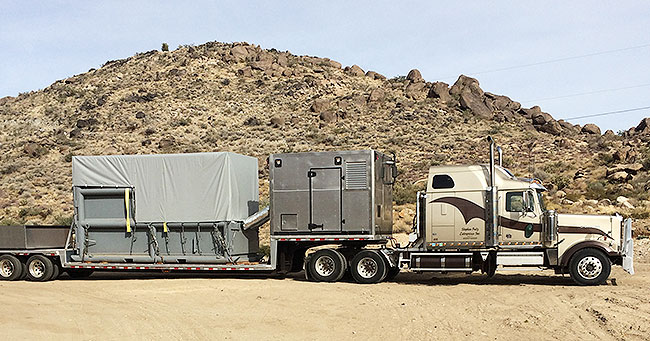
Stephen Fritz Enterprises uses a 2006 Western Star truck, plus two custom-built Jet Trailers to transport elephants in containers. (Stephen Fritz/Stephen Fritz Enterprises)
Fritz said although their use may be controversial among zookeepers and in particular animal rights activists, restraints help to avoid situations on the road that may compromise the stability of the truck and trailer.
“The restraints are necessary, primarily to keep them from turning themselves around inside the crate and getting themselves compromised,” he said.
Fritz said after their transports are completed, he and his wife try to visit as many of the 100 elephants they’ve moved over the years as possible.
“It’s a special feeling you have when you can see them doing well months or years later,” he said. “And they do recognize you. Elephants are incredibly smart animals and can bond with humans on a deep level. Transporting them is a remarkable experience.”
Want more news? Listen to today's daily briefing:


